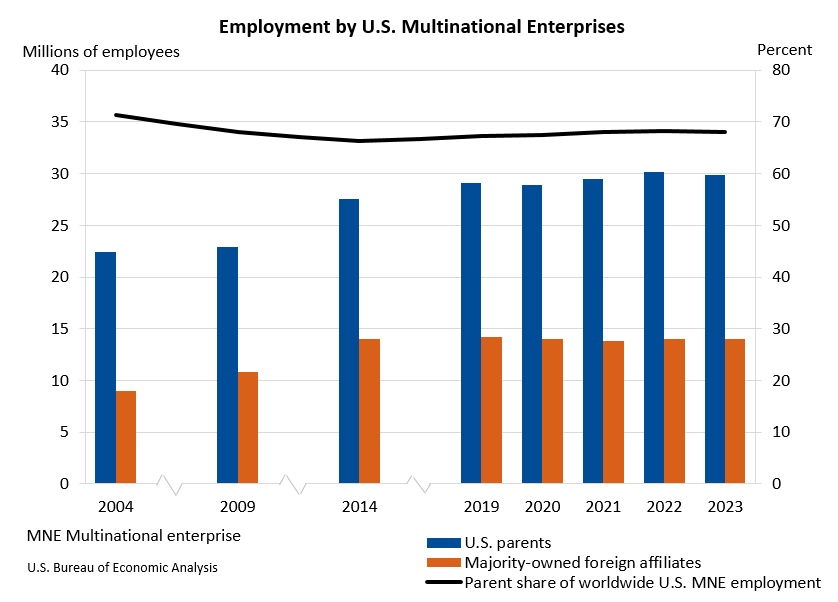Bureau of Economic Analysis
Activities of U.S. Multinational Enterprises, 2023
Worldwide employment by U.S. multinational enterprises decreased 0.4 percent to 43.9 million workers in 2023 (preliminary) from 44.1 million workers in 2022 (revised), according to statistics released today by the U.S. Bureau of Economic Analysis on the operations and finances of U.S. parent companies and their foreign affiliates.
Principal Federal Economic Indicators
Noteworthy
- 2025 News Release Schedule
- Innovation at BEA
- 2025 Annual Updates
- Distribution of Personal Income Nowcast
- New! Services Trade Data for More Countries
- Data Tool: Trade in Value Added
- Updated: RIMS II Regional Multipliers
- Arts and Culture
- Space Economy
- FDI Now in State BEARFACTS
- Quick Guide: Price Indexes
The Latest
Real Consumer Spending Rises in May
Personal income increased 0.5 percent in May, the same increase as in April. Wages and salaries, the largest component of personal income, rose 0.5 percent in May after rising 0.3 percent in April.
Current-dollar disposable personal income (DPI), after-tax income, increased 0.5 percent in May after rising 0.4 percent in April.
Real DPI, income adjusted for taxes and inflation, increased 0.2 percent in May…
Personal Income and Outlays, May 2015
Personal income increased $79.0 billion, or 0.5 percent, and disposable personal income (DPI) increased $65.5 billion, or 0.5 percent, in May, according to the Bureau of Economic Analysis. Personal consumption expenditures (PCE) increased $105.9 billion, or 0.9 percent. In April, personal income increased $69.6 billion, or 0.5 percent, DPI increased $57.0 billion, or 0.4 percent, and PCE increased $8.5 billion, or 0.1 percent, based on…
First-Quarter GDP Revised Up
Real gross domestic product (GDP) decreased 0.2 percent in the first quarter of 2015, according to the “third” estimate released by the Bureau of Economic Analysis. The growth rate was revised up 0.5 percentage point from the “second” estimate released in May. In the fourth quarter of 2014, real GDP increased 2.2 percent.
Gross Domestic Product, 1st quarter 2015 (third estimate); Corporate Profits, 1st quarter 2015 (revised estimate)
Real gross domestic product -- the value of the production of goods and services in the United States, adjusted for price changes -- decreased at an annual rate of 0.2 percent in the first quarter of 2015, according to the "third" estimate released by the Bureau of Economic Analysis. In the fourth quarter, real GDP increased 2.2 percent. The GDP estimate released today is based on more complete source data than were available for…
Travel and Tourism Spending Decelerated in the First Quarter of 2015
Real spending (output) on travel and tourism decelerated in the first quarter of 2015, increasing at an annual rate of 2.0 percent after increasing 4.9 percent (revised) in the fourth quarter of 2014. By comparison, real gross domestic product (GDP) turned down, decreasing 0.7 percent (second estimate) in the first quarter after increasing 2.2 percent.
Travel and Tourism Satellite Accounts, 1st quarter 2015
Real spending (output) on travel and tourism decelerated in the first quarter of 2015, increasing at an annual rate of 2.0 percent after increasing 4.9 percent (revised) in the fourth quarter of 2014. By comparison, real gross domestic product (GDP) turned down, decreasing 0.7 percent (second estimate) in the first quarter after increasing 2.2 percent.
State Personal Income: First Quarter 2015
State personal income grew 0.9 percent on average in the first quarter of 2015, after growing 1.1 percent in the fourth quarter of 2014. Personal income grew in 46 states and growth accelerated in 15 of those states. The fastest growth, 1.3 percent, was in Florida. Personal income fell in four states, with the largest decline, 1.2 percent, in Iowa. The national price index for personal consumption expenditures, fell 0.5 percent in the first…
First Quarter 2015 Travel and Tourism Spending Data to Be Released June 23
Statistics on what Americans and foreigners spent on travel and tourism in the United States in the first quarter of 2015 will be released Tuesday, June 23 by the Bureau of Economic Analysis (BEA).
The statistics, part of BEA’s Travel and Tourism Satellite Accounts, provide a breakdown of the various components of travel and tourism spending, including lodging, meals, air travel, and shopping. The statistics will also provide data on…
State Quarterly Personal Income, 1st quarter 2014 - 1st quarter 2015
State personal income grew 0.9 percent on average in the first quarter of 2015, after growing 1.1 percent in the fourth quarter of 2014, according to estimates released today by the U.S. Bureau of Economic Analysis. Personal income grew in 46 states and growth accelerated in 15 of those states. The fastest growth, 1.3 percent, was in Florida. Personal income fell in four states, with the largest decline, 1.2 percent, in Iowa.
Why Does BEA Revise GDP Estimates?
Each summer, the Bureau of Economic Analysis updates its Gross Domestic Product estimates to incorporate sources of data previously unavailable and make improvements in methodology –– all with the goal of providing the most accurate measure of the U.S. economy’s performance.




